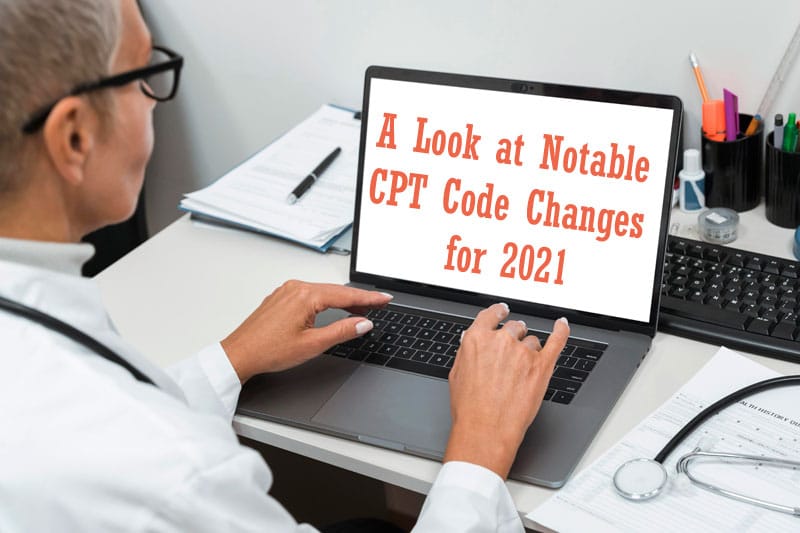Each year, the American Medical Association (AMA) CPT code updates. Providers rely on experts in medical billing and coding companies to keep track of these changes and accurately report and document CPT codes for the services rendered. The 2021 CPT code set, which went into effective on January 1, has 329 updates, including 206 new codes, 54 deletions and 69 revisions. Let’s take a look at the important changes.
- Revised Codes for Office and other Outpatient Evaluation and Management (E/M) Services: Revised E/M office visit codes are one of the most significant updates for 2021. Code 99201 Office or other outpatient visit for the evaluation and management of a new patient, has been deleted. Other key E/M office visit code changes include eliminating history and physician exam as elements for code selection, change in the definition of ‘time’ associated with 99202-99215, allowing code level selection based on medical decision-making, and inclusion of more detail in CPT code descriptors to support payer consistency.
- Prolonged Services: A new code – 99417 – has been introduced for reporting prolonged services along with an office visit. Code 99417, which replaces CPT codes 99354 and 99355, is meant for reporting the total prolonged time with and without direct patient contact on the same day as an office visit. Certain conditions apply to the use of the new code for prolonged services:
- 99417can only be reported in conjunction with the level 5 visit codes (CPT 99205, 99215).
- The time must exceed the minimum time for primary E&M service.
- Coding should be based on time alone.
- Chronic Care Management (CCM) Services: Code 99490 is reported at the 20-minute mark as usual. Code 99439 is the new code for 20 additional minutes. Code 99439 is reported in conjunction with 99490 for each additional 20 minutes of clinical staff time
directed by a physician or other qualified health care professional, per calendar month. - Cardiovascular: There are the new codes for cardiac shunting procedures. Codes 33741 and 33745 are for reporting creation of effective intracardiac blood flow in the setting of congenital heart defects. Code 33746 is for each additional intracardiac shunt location and is to be reported in conjunction with 33745)33741 Transcatheter atrial septostomy (TAS) for congenital cardiac anomalies to create effective atrial flow, including all imaging guidance by the proceduralist, when performed, any method (eg, Rashkind, Sang-Park, balloon, cutting balloon, blade)33745 Transcatheter intracardiac shunt (TIS) creation by stent placement for congenital cardiac anomalies to establish effective intracardiac flow, all imaging guidance by the proceduralist when performed, left and right heart diagnostic cardiac catherization for congenital cardiac anomalies, and target zone angioplasty, when performed (eg, atrial septum, Fontan fenestration, right ventricular outflow tract, Mustard/Senning/Warden baffles); initial intracardiac shunt33746 is used to describe each additional intracardiac shunt creation by stent placement at a separate location during the same session as the primary intervention (33745).Deleted: Atrial septectomy or septostomy codes 92992 (transvenous method, balloon) and 92993 (blade method) have been deleted.
- Audiologic Function Tests: The following three new codes have been added under auditory evoked potentials,92650 Auditory evoked potentials; screening of auditory potential with broadband stimuli, automated analysis92651 describes nonautomated follow-up electrophysiologic testing to rule out significant hearing loss, including auditory neuropathy/auditory dyssynchrony, or to verify the need for additional threshold testing92652 describes extensive electrophysiologic estimation of behavioral hearing thresholds using broadband and/or frequency-specific stimuli at multiple levels and frequenciesCode 94617 has been revised to pave the way for new code 94619, which describes exercise testing without electrocardiographic (ECG) recording
94617 Exercise testing for bronchospasm, including pre- and post-spirometry and pulse oximetry; with electrocardiographic recording(s)
94619 Exercise testing for bronchospasm Including spirometry and pulse oximetry, without electrocardiographic recording(s)
Other notable CPT code changes for 2021 include: new and revised codes to enhance screening and care of patients with diabetes,.15 revised breast reconstruction codes, updates to nervous system codes, 128 new laboratory codes, significant expansions to the descriptions of arthroscopic shoulder debridement codes, addition of a lung cancer screening code, new ultrasound treatment code for prostate cancer, and a new ob-gyn colposcopy mapping code. Finally, there are new CPT codes for coronavirus testing.
Mastering these updates can be a challenge for busy physician practices. Outsourcing medical billing and coding to an expert is the best way to keep up with CPT code changes and report procedures and services correctly to federal and private payers for optimal reimbursement.




